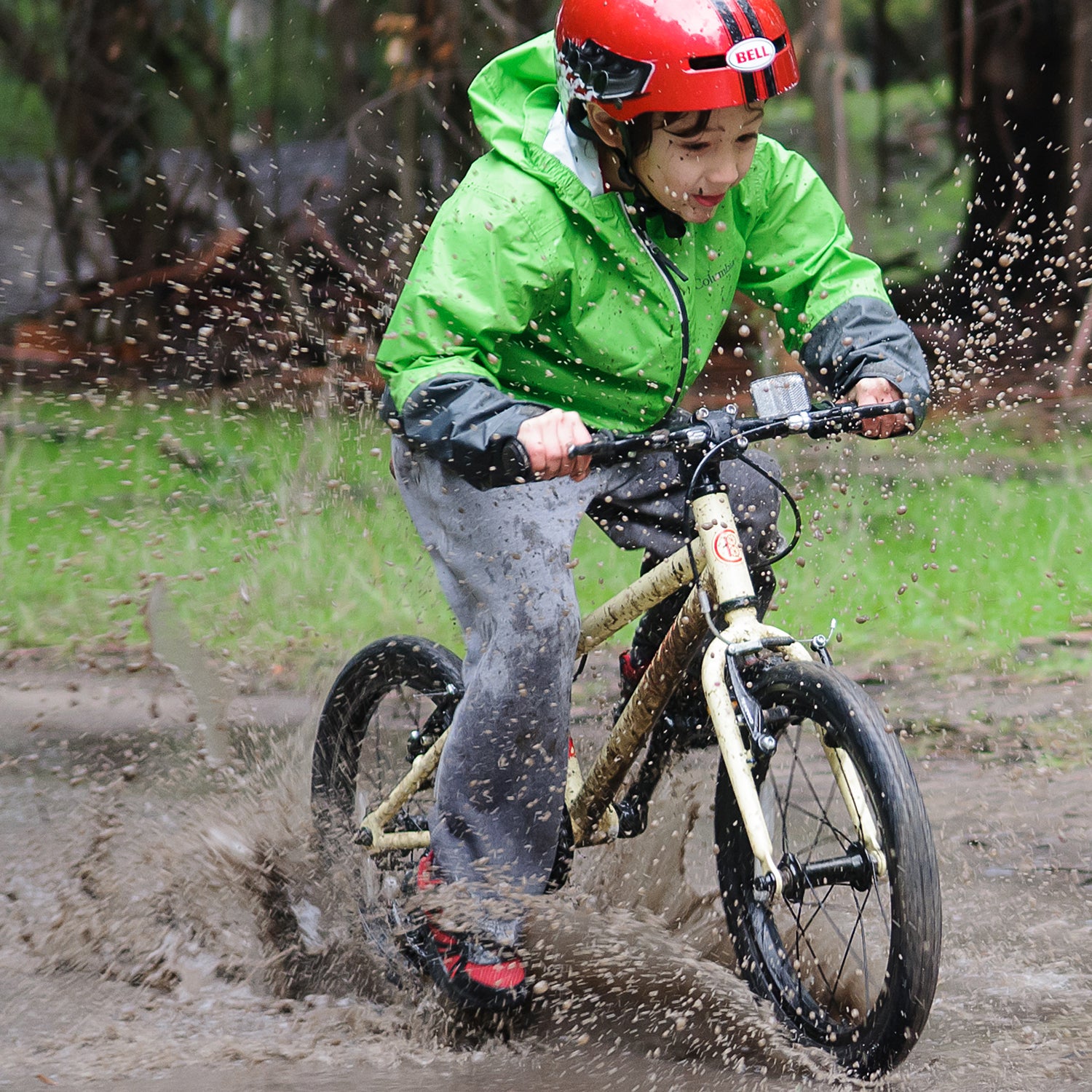David Weiner refused to buy his son a bike. His objection wasn’t the cost or concern for his kid’s safety. After all, Weiner founded New York City-based Priority Bicycles to provide average Janes and Joes with easy-button bicycles that would encourage people to ride more. But shopping for his toddler son, Jake, he discovered a sea of heavy, overbuilt clunkers that seemed more like a ball and chain than a ticket to freedom.
“There has been virtually no innovation in children’s pedal bicycles for generations,” he says. “We essentially teach our kids to pedal on the same bikes that we learned how to ride on.”
While adult models have become more sophisticated than ever, using lighter materials and ever-better components, development in kids’ bikes, with a few notable exceptions, like , has remained stagnant. That’s true not only at big-box, low-cost retailers, but also among reputable bike brands, which cite low sales margins for necessitating money-saving manufacturing norms.
“When you put a kid on a thoughtfully designed, lightweight performance bike, they’re going to love it.”
The result are heavy rides that aren't fun to pedal. Even Schwinn’s new SmartStart bikes (which feature improvements to the geometry and gearing) average 23 pounds for a 16-inch single-speed model; the 16-inch Specialized Hotrock (a single-speed for four- to six-year-olds) weighs 19 pounds—about half of its rider’s total body weight. That’s like giving a 170-pound man an 85-pound bike. Such effort may explain kids’ declining ridership: according to a 2011 analysis published by Gluskin Townley Group, the number of children who ride bicycles dropped more than 20 percent between 2000 and 2010.
So Weiner set out to make better bikes for kids. In October 2015, he debuted the Start C/B (with coaster and hand brakes, available in 12- or 16-inch wheel sizes) and the Start F/W (a 16-inch freewheel model with hand brakes only). Both feature lightweight aluminum frames with geometries that are optimized for kids and both use chainless, grease-free belt drives that minimize mess and maintenance. The F/W also bests the Hotrock by a pound.
Weiner is among the growing number of bicycle enthusiasts that are striving to create next-generation kiddie rides. Isla Rowntree introduced the movement back in 2006 by founding Islabikes, a U.K. company devoted exclusively to children’s bicycles. Instead of simply shrinking adult models (which tends to create a too-tall kid’s bike with a short, wobbly wheel base) she measured actual children to design geometries that improve balance, stability, and efficiency. Rowntree also developed proprietary handlebars, brakes, cranks, and saddles—all optimized for kids.
In 2013, . Around that same time, other brands—such as Sausalito-based Cleary Bikes, Spawn Cycles from Alberta, Canada, and Woom, an Austrian company—also started offering better kids’ models. “It’s really a response to balance bikes,” says Spawn founder Max Zureski, who maintains that old-school children’s bikes worked fine in previous decades, when most youngsters started riding at five, six, or seven years old. But the recent advent of Striders and other pedal-less “push bikes” has introduced biking to tots as young as 12 months old—and by the time they’re two or three, says Zureski, “They’ve gotten so good, so fast, that they need something that didn’t exist before.”
Zureski designed his first bike, the Furi, to fill that gap. A single-speed with 14-inch wheels, the Furi weighs just 14 pounds. Since its 2012 launch, Spawn Cycles has grown twenty-fold: the company just released the Rokkusuta, a full-suspension mountain bike with 140mm of travel front and rear and 24-inch wheels that let eight- to 10-year-olds hammer North Shore bike parks.
Admittedly, remains small, and production costs are high. To keep product prices from ballooning into the stratosphere, Spawn and other kid-centric brands sell most of their bikes via the web and other direct-to-consumer channels rather than through retailers (which claim a cut of the purchase price). Buyers therefore assume some responsibility for assembly, which varies in complexity from company to company. Islabikes and Woom models arrive practically ready to ride. Cleary and Spawn require parents (or the local bike shop) to install forks, headsets, and brakes.
But turning kids onto biking is worth the extra effort, says Jeff Cleary, who collaborated with Andy Holmes of Felt Bicycles on his initial launch. “When you put a kid on a thoughtfully designed, lightweight performance bike,” says Cleary, “they’re going to love it.”
Here’s how Cleary’s brainchild—and four other next-gen kiddie bikes—performed in testing.
Cleary Hedgehog 16” Single Speed ($310)
Tested weight: 17 lbs
With a noticeably longer wheelbase than most bikes this size, the Hedgehog lets little riders adopt the same kind of aggressive, forward-leaning body position adult mountain bikers typically favor. Internally routed brake cables streamline the build and help prevent damage from kids’ inevitably careless treatment, and levers sit close enough to the handlebar for short fingers to grab. The saddle is among the best we tested: light, svelte, and narrow enough for a five-year-old pelvis.
Downsides: The geometry doesn’t allow riders full leg extension (testers’ legs stayed sharply bent throughout the whole pedal stroke) and assembly is futzier than most.
Islabikes Beinn 20 small ($500)
Tested weight: 17 lbs
Attaching the pedals is all that’s required to assemble this seven-speed bike (and thoughtful labels on both pedals and cranks eliminates any confusion between left and right). Best-in-test componentry includes a SRAM drive train, a narrow, race-ready saddle, and proprietary brakes that Islabikes developed to create an easy reach for small hands. The grip shifter also sits within fingertip reach and let testers change gears without sweeping an arm across the handlebar. And the geometry turned every rider into a cycling ace: kids rode farther, faster, and with greater stability thanks to the comfortable body position they enjoyed while riding sidewalks and singletrack.
Woom 3 ($369)
Tested weight: 13 lbs
To Anglophones, the name sounds weirdly anatomical (in Austria, where this company is headquartered, “woom” pretty much means “zoom”) but this 16-inch bike proved to be transformative for kids lucky enough to take it for a spin. Amazingly light, this single-speed let testers double their typical mileage (after completing 12 miles on it, one five-year-old felt fresh enough for a playground session). Its geometry puts riders in an upright stance, which Woom says improves balance–and real-world riding seems to bear that out. Color-coded brake levers let kids learn the difference between front and rear brakes, and the speed-loving gearing helps them to fly (that’s a boon for zippy parents, and a drawback for those who want to restrict kids to slower speeds).
Bonus: Woom’s upcycling program refunds 40 percent of the original purchase price when parents buy the next-bigger bike.
Spawn Cycles Furi ($340)
Tested weight: 14 lbs
No coaster brakes on this 14-inch single-speed, just big-kid equipment: hand brakes on front and rear. That makes it the right fit for precocious three and four-year-olds that maxed out their push-bikes and need full-throttle gear. The lightweight built let 35-pound testers hammer singletrack and neighborhood circuits, the tires’ aggressive tread bit into dirt, and the nubbed pedals kept feet firmly in control. And what kid wouldn’t love the skull-and-crossbones logo?
Priority Start F/W ($259)
Tested weight: 18 lbs
Although it’s the heaviest bike we tested, this 16-inch single-speed is also the easiest to care for, requiring virtually nothing for parents to maintain. Instead of a chain (and its grease-related messes), a Gates carbon belt drive connects the bottom bracket to the rear hub. Not only is it smooth and silent, but it requires no cleaning or lubing—it just works, every time. And self-sealing tires keep tykes from being sidelined by a flat. The geometry puts five-year-old riders in a balanced, comfortable position.
Quibble: The cranks are shorter than some bikes we tested, and kept testers’ legs in a constant crouch.


